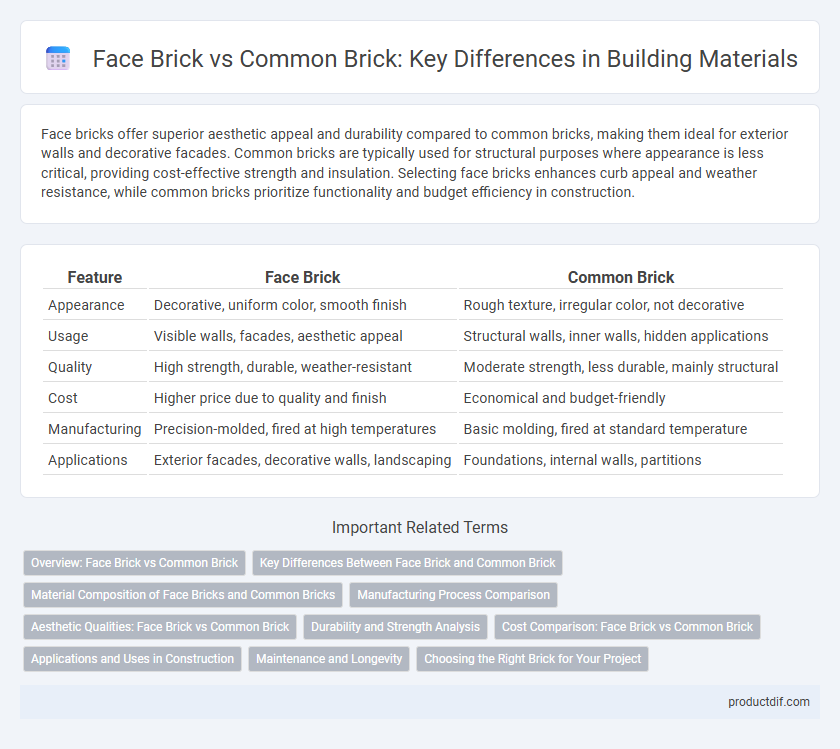Face bricks offer superior aesthetic appeal and durability compared to common bricks, making them ideal for exterior walls and decorative facades. Common bricks are typically used for structural purposes where appearance is less critical, providing cost-effective strength and insulation. Selecting face bricks enhances curb appeal and weather resistance, while common bricks prioritize functionality and budget efficiency in construction.
Table of Comparison
| Feature | Face Brick | Common Brick |
|---|---|---|
| Appearance | Decorative, uniform color, smooth finish | Rough texture, irregular color, not decorative |
| Usage | Visible walls, facades, aesthetic appeal | Structural walls, inner walls, hidden applications |
| Quality | High strength, durable, weather-resistant | Moderate strength, less durable, mainly structural |
| Cost | Higher price due to quality and finish | Economical and budget-friendly |
| Manufacturing | Precision-molded, fired at high temperatures | Basic molding, fired at standard temperature |
| Applications | Exterior facades, decorative walls, landscaping | Foundations, internal walls, partitions |
Overview: Face Brick vs Common Brick
Face brick offers a smooth, durable, and aesthetically pleasing exterior finish commonly used in visible wall surfaces, while common brick is typically utilized for structural applications hidden behind plaster or other finishes. Face bricks are manufactured with higher quality clay and fired at higher temperatures, resulting in enhanced color retention and resistance to weathering compared to common bricks. Common bricks are generally more affordable and have a rougher texture, making them suitable for internal walls and foundational work where appearance is less critical.
Key Differences Between Face Brick and Common Brick
Face brick offers superior aesthetic appeal, featuring smooth textures and uniform colors ideal for visible exterior walls, whereas common brick prioritizes structural integrity and cost-efficiency with a rougher surface and less uniform color. Face bricks provide greater resistance to weathering and require minimal maintenance compared to common bricks, which are often used as load-bearing materials in concealed applications. The manufacturing process for face brick includes higher quality clay and firing techniques to enhance durability and appearance, while common bricks are produced for rapid, large-scale construction needs.
Material Composition of Face Bricks and Common Bricks
Face bricks are typically composed of high-quality clay or shale with added minerals to enhance color, texture, and durability, providing a visually appealing and weather-resistant finish. Common bricks are primarily made from lower-grade clay or shale, often mixed with sand and other fillers, resulting in a less uniform and rougher surface primarily intended for structural purposes. The firing process for face bricks is usually more controlled to achieve consistent strength and aesthetic properties, whereas common bricks undergo standard firing focused on functionality.
Manufacturing Process Comparison
Face bricks undergo a more refined manufacturing process involving higher-quality clay, precise molding, and controlled firing temperatures to ensure uniformity, color consistency, and enhanced durability. Common bricks are typically produced using a simpler, less controlled process with local clay and may include more impurities, resulting in variable appearance and lower strength. The advanced manufacturing techniques of face bricks contribute to their smooth finish and suitability for visible facades, whereas common bricks prioritize cost-efficiency for structural purposes.
Aesthetic Qualities: Face Brick vs Common Brick
Face bricks offer superior aesthetic qualities with consistent colors, smooth textures, and precise shapes that enhance architectural design. Common bricks typically have a rougher surface and irregular coloration, making them more suitable for structural applications rather than visible finishes. The uniform appearance of face bricks provides a polished, decorative facade that improves curb appeal and resale value.
Durability and Strength Analysis
Face bricks exhibit higher durability and compressive strength compared to common bricks, making them ideal for exterior facades exposed to harsh weather conditions. Their dense composition and low water absorption rate enhance resistance to frost, wear, and chemical erosion. Common bricks, while cost-effective, generally have lower strength and higher porosity, limiting their use primarily to non-structural, interior, or backup wall applications.
Cost Comparison: Face Brick vs Common Brick
Face brick generally costs more than common brick due to its superior aesthetics, durability, and manufacturing process. Common bricks are more economical, making them suitable for structural applications where appearance is not critical. Choosing between face brick and common brick depends on budget constraints and the desired finish for the building project.
Applications and Uses in Construction
Face bricks are primarily used for exterior walls and facades due to their aesthetic appeal, durability, and weather resistance, making them ideal for visible architectural finishes. Common bricks are typically employed in structural applications such as internal walls, partitions, and foundations where strength and cost-effectiveness are prioritized over appearance. Both types play distinct roles in construction, with face bricks enhancing visual impact and common bricks providing robust support in non-exposed areas.
Maintenance and Longevity
Face bricks offer superior durability and low maintenance due to their dense composition and weather-resistant surface, making them ideal for exterior facades. Common bricks tend to absorb more moisture, requiring frequent sealing and repairs to prevent cracking and spalling over time. The enhanced longevity of face bricks reduces lifecycle costs, supporting sustainable building practices with less frequent replacement needs.
Choosing the Right Brick for Your Project
Face brick offers superior aesthetics, durability, and weather resistance, making it ideal for visible exterior walls and enhancing curb appeal. Common brick, often less expensive and less uniform, serves well for structural purposes or interior applications where appearance is not critical. Selecting the right brick depends on factors such as budget, exposure to elements, and desired finish quality.
Face Brick vs Common Brick Infographic

 productdif.com
productdif.com